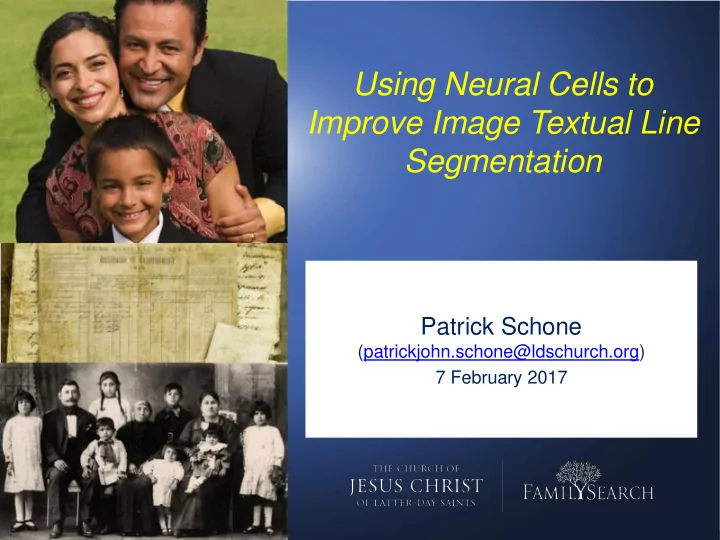

Using Neural Cells to Improve Image Textual Line Segmentation Patrick Schone (patrickjohn.schone@ldschurch.org) 7 February 2017 Standards Technical Conference
Overview • Motivation • Neural Cells for Line Counting • Hybrid Segmentation • Evaluation Methods 2
Motivation • To do OCR/HWR, usually need to break up into lines. • Most use common image processing &/or statistics. • Techniques work fine on small / homogeneous sets. • Huge heterogeneous DBs are a challenge. • Activity or Connectivity vs intentionality. • Deep Neural Nets can be taught some about human- ness. Can they be useful for line segmentation? 3
Base System: “ PreDNN ” We start off with a system we call “ PreDNN ” with the following properties: • Multi-swath projection • Bi-directional Dynamic programming with two-pass seam carving (first detects peaks, the troughs) • Grayscale-based • Use of connected components to help detect false lines or falsely merged lines. • Statistical analyses to discard overgenerated peaks or troughs We believe that this PreDNN rivals the state of the art . 4
DNNs to Count Lines Want to create a neural network that can determine if we find well-segmented lines. A B C D E F G Category A No-text Line B Single Text Line C Vertical Bar Only D Less Than One Text Line E Two Fragment Lines F More than one but less than two lines G Two-plus Line 5
Tagged Cells: Counts # in TRAIN # in TEST No-text Line 7330 625 Single Text Line 12651 848 Vertical Bar Only 703 89 Less Than One Text 16813 1098 Line Two Fragments 5027 407 More than one less 8573 801 than two Two-plus Line 14162 1409 Totals 70.5K 5.3K 6
Tagged Cells: Counts II Note that the “lined - ness” of a cell is still the same even if the image has been rotated 180 degrees of flipped with respect to y- axis. We will refer to these as the “legal permutations.” Using the legal permutations, we have 4 times more train/test: 280K training 21K testing. 7
The DNN We train a Convolutional Neural Network for line count prediction. We use Google’s TensorFlow. And use a variant of their MNIST-Digit-Recognition recipe. Except, for speed, we reduce the parameters: Kernel Size = 3 Layer #1 = 16 Layer #2 = 32 Layer #3 = 216 This yields a network with 91.0% accuracy . HOWEVER, we can get about 2% improvement by either considering the four permutations or by overlapping decision regions and voting. 8
Line Counter= Line Fixer Potential Usage: How about if we just apply the system to PreDNN’s outputs and then try to correct? Example to the right is one where line segmenter does poorly. Can we fix it ? 9
Line Counter = Line Fixer Start off by colorizing the image. For each swath, cut into overlapping regions. Predict color of each region. Use voting to predict most likely color of each intersected area. 10
Line Counter = Line Fixer Compute “Greenness”: # GREEN Cells + 0.1* (#PINK + #PURPLE) Cells ---------------------------------------------------------------------- # GREEN + 0.1* (#PINK + #PURPLE) + #{BLUE, RED, YELLOW, ORANGE} Greenness = 69.9% 11
Line Counter = Line Fixer We created formulas that comparing each row to the one above/below: Symptoms of Potential False Split: Blue/Blue: Likely split Blue/Pink: Possible split Green/Pink: Slight chance of split Green/Green: Probably OK Etc. Symptoms of Potential False Merge: Red/Green: Likely Merge Red/Red: Almost definite merge Red/Orange: Probable merge 12
Line Counter = Line Fixer We handle potential false splits first, then false merges. We sort from the most likely to the least, and throw out candidates with low scores. For potential false splits (and fusions would be similar): <= Start with row pair. Offline, merge cells and evaluate. <= If the results are better, replace the original with the new. <= If results are worse, though, skip that potential pairing. 13
Line Counter = Line Fixer Using this process, we are able to completely fix what was broken. The resultant image’s line segmentation has 100% greenness! 14
Evaluation Methods Option 1: Score against human-vetted lines. Do-able, but costly to evaluate. Option 2: Evaluate by Greenness Very inexpensive, but “cheating” a bit Option 3: Evaluate by Recognition Ultimately, our end goal, so this is good eval. 16
Evaluation Option 2: Evaluate by Greenness PreDNN PostDNN # of 95+% green 69 92 # of 90-94% green 47 58 # of 80-89% green 52 46 # of 70-79% green 31 14 # Below 70% green 20 9 Average Greenness 86.88% 91.30% 17
Evaluation Option 3: Evaluate by Recognition: We built a test collection of 565 handwritten, prose-style US legal documents with 137K test words. Also trained a handwriting recognition system using comparable but different training documents. Then ran recognition using both PreDNN and PostDNN systems: PreDNN PostDNN HWR Word 83.9% 85.1% Accuracy Line Segmentation cost 19% more, but recognition costs 11% less because there are fewer lines. So for fairly comparable costs, we get 1.2% absolute gain. 18
Synopsis • Can detect line count at the cellular level. • Greenness: allows one to detect areas of potential problems. • Neural improves segmentation of an already-good system. • We expect it to be applicable w/ other systems. • Final segmentation actually results in HWR improvements. ANY QUESTIONS? 19
Recommend
More recommend